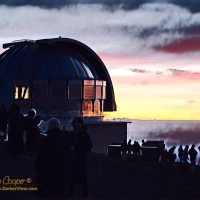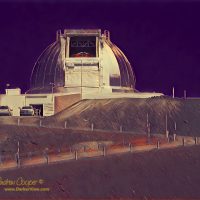After last year’s debacle that occurred when trying to introduce administrative rules for public and commercial access to Mauna Kea, the University of Hawaii is back with a heavily revised version.
How bad were the original version of the rules? In many areas they seemed to be badly thought out, with language far too expansive. Even a cursory reading reveals that the rules were not reviewed by someone familiar with some of the technical language used. Many of the proposed rules would have created safety issues, or even devoid of common sense.
It does appear that they actually listened to the criticism that was received in written form and at the public hearings. Many of the complete gaffes have been removed or reasonably revised.
The rules so concerned me that I attended one of the public hearings. Being an observatory employee you would expect that I would support OMKM and the observatories on this… No, I most certainly did not. Is it bad when prominent telescope protesters come up and shake your hand after your testimony?
It was no surprise when I later heard that the proposed rules were to be withdrawn and revised. I was even contacted with respect to some of the revisions.
The revised proposed rules were published last week and I have had time to read through them. Shall we look to see how the draft has changed? What has changed? Is this new draft any better? A few examples?
§20-26-34 Audio devices and noise. Creating noise or sound within UH management areas, either vocally or otherwise, including but not limited to public address systems, radios, television sets, musical instruments, or use of any noise producing devices, such as electric generating plants or other equipment driven by motors or engines, in a manner and at times that create a nuisance is prohibited.
Chapter 20-26, proposed draft, first 2018 version
Yes, they were actually trying to regulate talking. I guess we are all supposed to be silent on the mauna? True, there is that clause about being a nuisance. Sorry, that sort of language is up to the enforcement officer and can be interpreted on a whim.
§20-26-33 Audio devices and noise. Creating noise or sound within UH management areas using public address systems or other audio amplifying devices, or using electric generating plants or other equipment driven by motors or engines, in a manner and at times that create a nuisance is prohibited.
Chapter 20-26, proposed draft, revised, January 2, 2019
The new paragraph on this subject is much better, regulating amplified sound only. This would address the true issue of concern without the expansive language that could so easily be misused if blindly enforced.
One of the more contentious paragraphs concerns interference with the observatories, including radio transmitters or the the use of artificial illumination. This was testified to by several people at the public session I attended, including myself.
§20-26-24 Preservation of scientific and educational resources. The following activities are prohibited within the UH management areas:
Chapter 20-26, proposed draft, first 2018 version
(1) Using any electro-magnetic device, including but not limited to radio transmitters and cellular telephones, except for use in an emergency;
(2) Using wireless communication technologies, except for use in an emergency;
(3) Using artificial illumination, except for headlights on licensed motorized vehicles; or
(4) Conducting any other activity that materially interferes with the scientific and educational operations of the astronomical facilities or research equipment or with the protection of the scientific resources.
What is an ‘electro-magnetic device’? Basically any electrical device is covered by this language, to include cameras, vehicles, wrist watches, or pacemakers. This is not only ridiculously expansive, it is totally overboard. Clearly whomever wrote this rule did not understand the technical terminology.
No form of artificial illumination? Have you ever tried to walk around on the mauna without light. Small boulders disappear on the dark cinder, drop-offs are invisible. To not use a flashlight is extraordinarily unsafe to verge on suicidal.
§20-26-23 Preservation of scientific and educational resources. The following activities are prohibited within the UH management areas north of Halepōhaku:
Chapter 20-26, proposed draft, revised, January 2, 2019
(1) Using any radio transmitter, including but not limited to two-way radios, Wi-Fi and Bluetooth devices, and cellular telephones; provided that, cellular telephones may be used for emergency purposes or when radio transmission is suspended, for example by using airplane mode;
(2) Directing artificial illumination, for example, lasers and flashlights, at or near observatories; or
(3) Conducting any other activity that materially interferes with the scientific and educational operations of the astronomical facilities or research equipment or with the protection of the scientific resources.
This is vastly better than the first draft, revising the absurd prohibition on electromagnetic devices to indicate transmitters only. The new language specifically addresses intentional interference with the observatories while not attempting to regulate simple use of a flashlight to safely walk about. A small flashlight directed downwards is of no real concern, the instruments are not that sensitive.
One more example of the extensive revisions can be seen in the enforcement and fines to be levied for violations of the chapter. This section drew particular ire from the telescope opponents who came to testify.
The previous version had fines that started at $2500 for simple infractions, simply out of proportion to the violation. Not only were the rules so broad that practically any visitor to the mauna was in violation of something, you could now be punitively fined for it.
The new section on administrative enforcement allows for lower fines starting at $500 for many types of infractions of the rules. The process to administer those fines seems oddly complex, this section will take closer reading to understand what is going on here. Why do these rules create an entirely new enforcement process rather than relying on the already existing DLNR process?
That is enough of comparing the old to new revision, it is time to consider the new proposed ruled on the merits. Stay tuned to DarkerView for a more in-depth analysis of the proposed rules. I intend to examine the newly proposed rules. While they are much better, they do have some issues that should be considered more closely.



